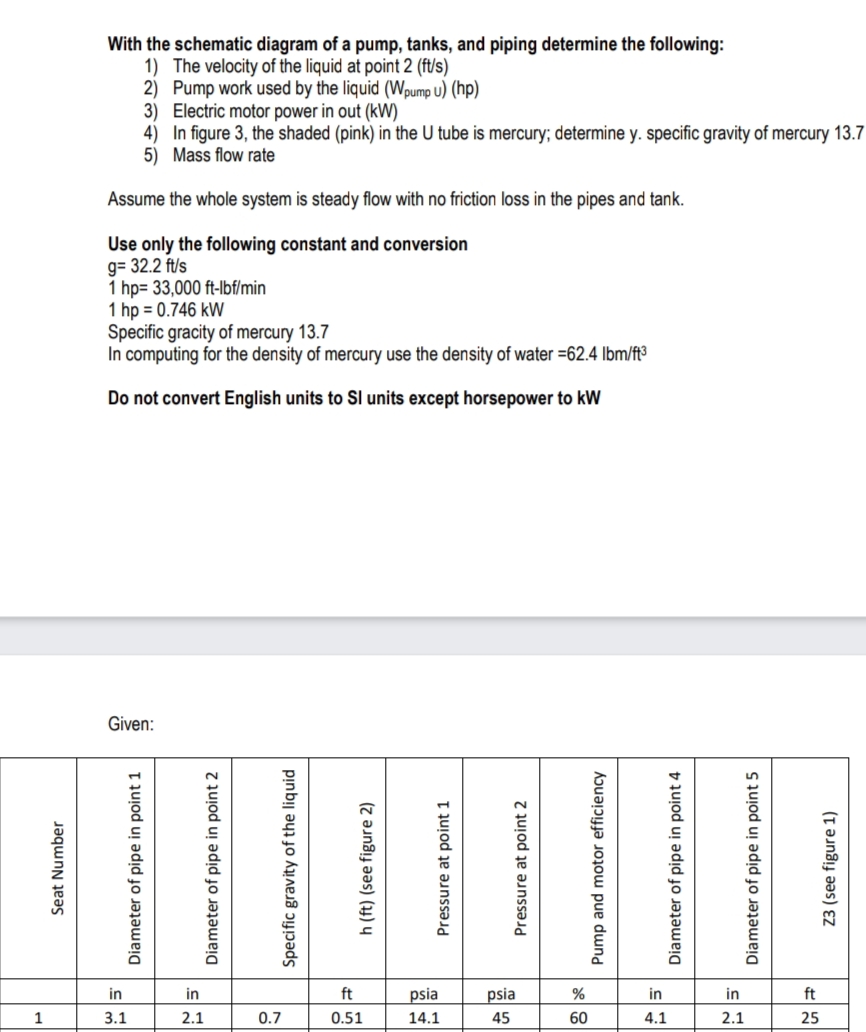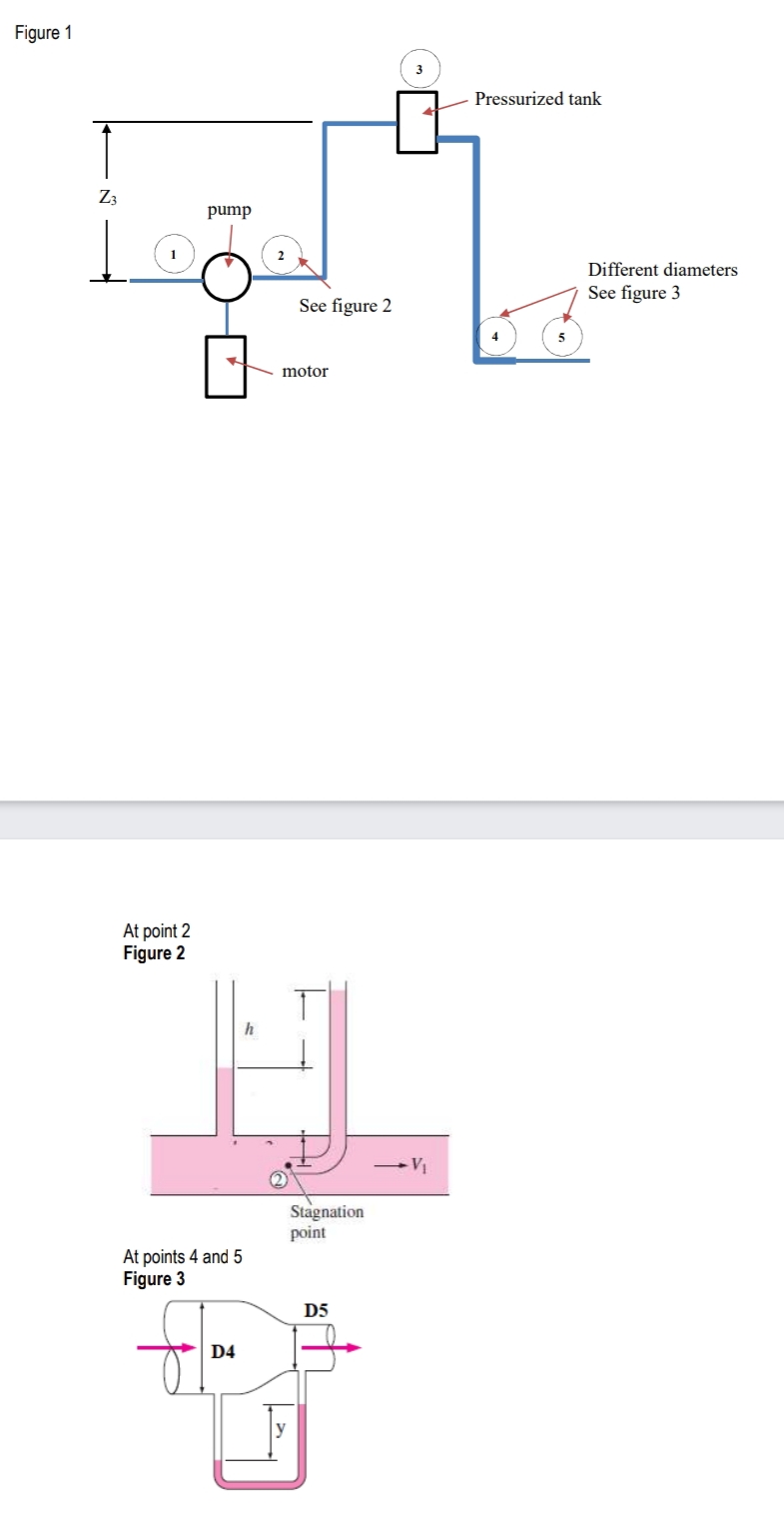With the schematic diagram of a pump, tanks, and piping determine the following: 1) The velocity of the liquid at point 2 (ft/s) 2) Pump work used by the liquid (Wpump U) (hp) 3) Electric motor power in out (kVW) 4) In figure 3, the shaded (pink) in the U tube is mercury; determine y. specific gravity of mercury 13.7 5) Mass flow rate Assume the whole system is steady flow with no friction loss in the pipes and tank. Use only the following constant and conversion g= 32.2 ft/s 1 hp= 33,000 ft-Ibf/min 1 hp = 0.746 kW Specific gracity of mercury 13.7 In computing for the density of mercury use the density of water =62.4 lbm/ft³ Do not convert English units to SI units except horsepower to kW Given: in in ft psia psia in in ft 1 3.1 2.1 0.7 0.51 14.1 45 60 4.1 2.1 25 Seat Number Diameter of pipe in point 1 Diameter of pipe in point 2 Specific gravity of the liquid h (ft) (see figure 2) Pressure at point 1 Pressure at point 2 Pump and motor efficiency Diameter of pipe in point 4 Diameter of pipe in point 5 Z3 (see figure 1) Figure 1 Pressurized tank Z3 pump Different diameters See figure 3 See figure 2 motor At point 2 Figure 2 V1 Stagnation point At points 4 and 5 Figure 3 D5 D4 y
With the schematic diagram of a pump, tanks, and piping determine the following: 1) The velocity of the liquid at point 2 (ft/s) 2) Pump work used by the liquid (Wpump U) (hp) 3) Electric motor power in out (kVW) 4) In figure 3, the shaded (pink) in the U tube is mercury; determine y. specific gravity of mercury 13.7 5) Mass flow rate Assume the whole system is steady flow with no friction loss in the pipes and tank. Use only the following constant and conversion g= 32.2 ft/s 1 hp= 33,000 ft-Ibf/min 1 hp = 0.746 kW Specific gracity of mercury 13.7 In computing for the density of mercury use the density of water =62.4 lbm/ft³ Do not convert English units to SI units except horsepower to kW Given: in in ft psia psia in in ft 1 3.1 2.1 0.7 0.51 14.1 45 60 4.1 2.1 25 Seat Number Diameter of pipe in point 1 Diameter of pipe in point 2 Specific gravity of the liquid h (ft) (see figure 2) Pressure at point 1 Pressure at point 2 Pump and motor efficiency Diameter of pipe in point 4 Diameter of pipe in point 5 Z3 (see figure 1) Figure 1 Pressurized tank Z3 pump Different diameters See figure 3 See figure 2 motor At point 2 Figure 2 V1 Stagnation point At points 4 and 5 Figure 3 D5 D4 y
Elements Of Electromagnetics
7th Edition
ISBN:9780190698614
Author:Sadiku, Matthew N. O.
Publisher:Sadiku, Matthew N. O.
ChapterMA: Math Assessment
Section: Chapter Questions
Problem 1.1MA
Related questions
Topic Video
Question
Show complete and correct solution, thank you.

Transcribed Image Text:With the schematic diagram of a pump, tanks, and piping determine the following:
1) The velocity of the liquid at point 2 (ft/s)
2) Pump work used by the liquid (Wpump U) (hp)
3) Electric motor power in out (kVW)
4) In figure 3, the shaded (pink) in the U tube is mercury; determine y. specific gravity of mercury 13.7
5) Mass flow rate
Assume the whole system is steady flow with no friction loss in the pipes and tank.
Use only the following constant and conversion
g= 32.2 ft/s
1 hp= 33,000 ft-Ibf/min
1 hp = 0.746 kW
Specific gracity of mercury 13.7
In computing for the density of mercury use the density of water =62.4 lbm/ft³
Do not convert English units to SI units except horsepower to kW
Given:
in
in
ft
psia
psia
in
in
ft
1
3.1
2.1
0.7
0.51
14.1
45
60
4.1
2.1
25
Seat Number
Diameter of pipe in point 1
Diameter of pipe in point 2
Specific gravity of the liquid
h (ft) (see figure 2)
Pressure at point 1
Pressure at point 2
Pump and motor efficiency
Diameter of pipe in point 4
Diameter of pipe in point 5
Z3 (see figure 1)

Transcribed Image Text:Figure 1
Pressurized tank
Z3
pump
Different diameters
See figure 3
See figure 2
motor
At point 2
Figure 2
V1
Stagnation
point
At points 4 and 5
Figure 3
D5
D4
y
Expert Solution
This question has been solved!
Explore an expertly crafted, step-by-step solution for a thorough understanding of key concepts.
Step by step
Solved in 3 steps

Knowledge Booster
Learn more about
Need a deep-dive on the concept behind this application? Look no further. Learn more about this topic, mechanical-engineering and related others by exploring similar questions and additional content below.Recommended textbooks for you

Elements Of Electromagnetics
Mechanical Engineering
ISBN:
9780190698614
Author:
Sadiku, Matthew N. O.
Publisher:
Oxford University Press

Mechanics of Materials (10th Edition)
Mechanical Engineering
ISBN:
9780134319650
Author:
Russell C. Hibbeler
Publisher:
PEARSON

Thermodynamics: An Engineering Approach
Mechanical Engineering
ISBN:
9781259822674
Author:
Yunus A. Cengel Dr., Michael A. Boles
Publisher:
McGraw-Hill Education

Elements Of Electromagnetics
Mechanical Engineering
ISBN:
9780190698614
Author:
Sadiku, Matthew N. O.
Publisher:
Oxford University Press

Mechanics of Materials (10th Edition)
Mechanical Engineering
ISBN:
9780134319650
Author:
Russell C. Hibbeler
Publisher:
PEARSON

Thermodynamics: An Engineering Approach
Mechanical Engineering
ISBN:
9781259822674
Author:
Yunus A. Cengel Dr., Michael A. Boles
Publisher:
McGraw-Hill Education

Control Systems Engineering
Mechanical Engineering
ISBN:
9781118170519
Author:
Norman S. Nise
Publisher:
WILEY

Mechanics of Materials (MindTap Course List)
Mechanical Engineering
ISBN:
9781337093347
Author:
Barry J. Goodno, James M. Gere
Publisher:
Cengage Learning

Engineering Mechanics: Statics
Mechanical Engineering
ISBN:
9781118807330
Author:
James L. Meriam, L. G. Kraige, J. N. Bolton
Publisher:
WILEY